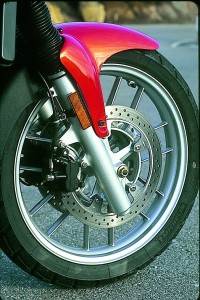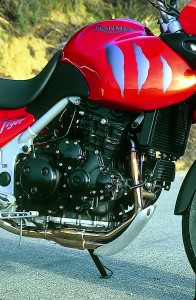When a rider contemplates getting a new bike, the very first consideration is usually which type of bike it should be. Should it be a cruiser or sportbike, dresser tourer or sport tourer, dual-sport or naked standard? As the motorcycling market has matured, it slices and dices and sifts its models to an increasingly fine degree.
With that in mind, you’ll have a hard time fitting Triumph’s 2005 Tiger into a specific category. With standard hard saddlebags it’s obviously a tourer. Its tall fork, big tank, semi-knobby tires and 33-inch seat height indicate that it must be an adventure tourer, like the BMW R1200GS. However, while that was the Tiger’s original intent when it was introduced for 1995, for 2005 it has been softened to create more of a comfortable street bike than dirt-road blaster.
Chassis changes for 2005 start with a wheelbase that has been reduced from 60.5 to 59.6 inches, as the aluminum swingarm has been shortened slightly and made stiffer. Along with this goes a revised rear caliper carrier and attendant hardware.
On the updated front suspension the fork legs are now 1.6 inches shorter, with travel reduced about an inch to 6.8 inches. The single-rate fork springs are now stiffer, and rebound damping has been increased 20 percent. In the rear, the spring rate has been increased 10 percent, with compression damping increased 40 percent and rebound by 20 percent. Rake has been tightened to 25.8 degrees (from 28 degrees), and trail is now 3.3 inches (from 3.7 inches), a result of the shorter fork legs and swingarm. These suspension changes are designed to enhance street handling and reduce fork dive under braking.
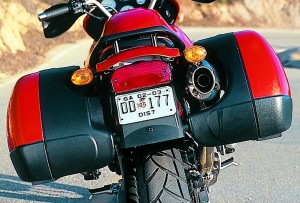
The Tiger’s gearshift and rear brake pedals have been slotted for lightness and are now sexier…if you can think of pedals in those terms. Replacing the wire wheels are new 14-spoke cast wheels that carry lighter brake discs and floating calipers.
After having put more than 1,000 miles on the new Tiger, I can assure you of one thing-the bike offers a tremendous fun factor. It reminds me a great deal of-and compares very favorably with-the Suzuki V-Strom DL1000, which the staff enjoyed immensely for its power, handling and comfort. Consider the Tiger a more streetable adventure bike.
The Tiger is powered by Triumph’s liquid-cooled, 955cc in-line, transversely mounted triple with dual overhead cams and chain final drive; it hangs from a steel backbone frame. Fuel is delivered by means of electronic injection, and thanks to the latter and its attendant black boxes it requires neither choke nor fast-idle control for starting. The key is up on the instrument panel and, hot or cold, the Tiger starts easily with a jab at the starter button.
Jump aboard the new Tiger, and immediately notice you’d better be rather long in the inseam department to feel secure. The rider’s portion of the seat easily adjusts from high (33.1 inches of seat height) to higher (33.4 inches) to highest (33.8) with the easy adjustment of a bracket underneath.
The sidestand is a tad long and stands the bike relatively upright, so on level pavement the rider gets the uneasy impression that a strong wind could topple the parked bike. Once aboard, you’ll need relatively long fingers to handle the cable-actuated clutch and front brake levers. They’re a bit of a reach, and neither offers an adjustment wheel. The clutch lever’s pull is stout, and became tiring by the end of the day.
One way the Tiger earns its stripes is that engine performance is a delight; power begins at about 2,500 rpm and this triple pulls quickly and immediately right off idle. Power builds seamlessly to its 9,500-rpm redline. Delivery is smooth till about 6,000 rpm, where vibes begin to jingle in the pegs and grips. Still, it’s never a problem for touring as that rpm translates to somewhere around 90 mph in the Tiger’s tall sixth gear.
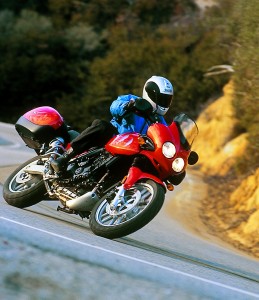
Seating is upright on a firm, narrow seat as the rider grasps a high, wide handlebar. As anyone who has ridden a dual-sport can affirm, this position is excellent for tight, winding roads; the rider has a good view from this perch and excellent leverage on the bar. With a little weight shift to help the bike into turns, a skilled Tiger tamer can give sportbike riders a run for their money.
The fork offers single-rate springs with revised rebound damping rates for 2005, but no external adjustments. We found the damping rates well suited to the bike, though still on the soft side. Despite the suspension changes, the fork springs are a tad soft, and the Tiger has a bit more fork dive under heavy braking than we would prefer. The fork gaiters are much too long, and compress to the point where they look sloppy and misshapen, like a pair of baggy pants. At the other end the single shock offers spring preload and about 20 rebound damping positions; setting the latter requires the use of a long-handled, flat-bladed screwdriver.
Steering is precise, crisp and secure. New this year are cast 14-spoke aluminum wheels with tubeless tires, a 110/80-V19 front and 150/70-V17 rear. Our bike was equipped with Michelin Anakee tires, and they are excellent. For my test I loaded the bags, added a large duffel on the back seat and swept off with my good buddies, squirreling around California’s backroads playing Stupid Old Guys Trying To Go Fast. Though they have the blocky look of dual-sport tires, the Anakees handle much like quality street tires. Steering is light and neutral; at extreme lean angles the Anakees give the impression they’re leaning in more than expected. This contributes to tenacious grip and a very secure feeling, as if the bike were biting into the turns. The only symptom of the blocky tread is a slight rumble felt vaguely through the grips, but certainly worth the tradeoff.
Triumph fitted the Tiger with dual disc brakes up front clamped by twin-piston calipers, and the usual single rear disc. While adequate, these two-piston jobs don’t offer quite the eyeball-bulging stopping power of more advanced systems. Also, fork dive limits the comfort level of really hard stops.
The Tiger’s six-speed transmission shifts quickly, easily and with only a slight bit of notchiness. It’s just below the ultimate praise of, “it shifts like a Japanese bike.”
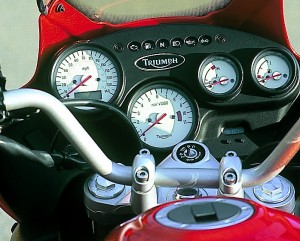
Those who entertain any thoughts of taking the Tiger offroad will note immediately that first gear is rather tall for any sort of plonking around on rough roads or fire trails, and don’t even think of deep sand. Secondly, while the Tiger carries a bash plate, it’s a vestigial little thing that attaches-whoa-directly to the exhaust pipes! So, bash the plate and you bash the pipes, too. Because the engine hangs from the backbone frame, there are no frame members to which it can be attached. The plate is so small that it leaves the collector completely exposed under the engine. Again, while dirt roads are OK, we do not recommend taking the Tiger offroad.
Touring comfort demands at least minimal wind protection, and the Tiger’s frame-mounted fairing and shield are better than minimal. At highway speeds they push the windblast away from the rider’s torso and out to shoulder level, which is certainly more protection than one would expect from this little shield. Combine that with the large plastic hand protectors and the rider can be quite comfy. We would have welcomed the optional heated handgrips on our bike; a centerstand is also optional.
Those of us fortunate enough to have spent some quality time with bikes such as the BMW GS or Suzuki V-Strom can verify the fact that these types of bikes are wonderful fun. And so it is with the Tiger. Its quick steering makes it a delight on a winding road, and power is more than adequate. The dyno shows it offers a solid 88.5 peak rear-wheel horsepower at 9,500 rpm, matched by 60.4 lb-ft of torque at 5,100 rpm, with 50-plus lb-ft available from 3,500 rpm. Start with excellent power, add great shifting, stir in decent braking and the solid-feeling Anakees, and the Tiger can really motor through a series of turns.
The color-matched hard saddlebags, which used to be a $1,250 option, now come standard and are a real plus for traveling. Because the exhaust pipe is routed high and tight to the bike, the right-side saddlebag’s back has to conform to it, and thus loses most of its capacity; most storage is solely in its lid. The left-side bag is full-sized. Both bags come with a pair of lockable flip latches, which help to draw them closed when overloaded. The bags lock to the bike and are easily removable with the turn of a key.
Another major convenience is the aluminum luggage rack, upon which Triumph recommends that you carry no more than 11 pounds. It’s got plenty of slots to which a bungee cord will easily hook.
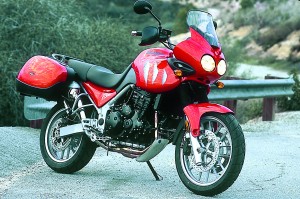
The tank holds 6.3 gallons of a recommended 95-RON (about 91 PON or Super in the United States) octane fuel, needed for its high compression ratio of 11.6:1. With the 42.9 mpg our bike produced during our usual hard usage, its theoretical range is a whopping 270 miles.
There are a few nits to pick with the Tiger. It really could have used adjustable levers, as the reach is rather far. Because of the odd, flowing shape of the plastic fuel tank, and its relatively small flat area on top, it’s difficult to mount a conventional tankbag, and a magnetic bag is out of the question. Regarding accessories, Triumph offers not only a tankbag, but also luggage liner bags, a matching hard trunk and more for the Tiger. Heated grips, fender extensions and a centerstand are also available, but none was on our test bike. All Tigers have a silver frame and wheels, and body color choices include British Racing Green, Lucifer Orange and Aluminum Silver.
So, how do we slice the Triumph Tiger? If you’re looking for a true adventure tourer, with suitable rough-road handling and engine protection, we’d have to suggest that other models are more suitable. However, if you want a great backroad- and dirt-road-traveling bike at a great price, we strongly suggest you take a Tiger by the tail.
If you are interested in the 2005 Triumph Tiger 1050, you might also be intersted in these other Triumph Tiger reviews from Rider: 2011 Triumph Tiger 800 and Tiger 800XC Review, 2007 Triumph Tiger 1050 Review.
